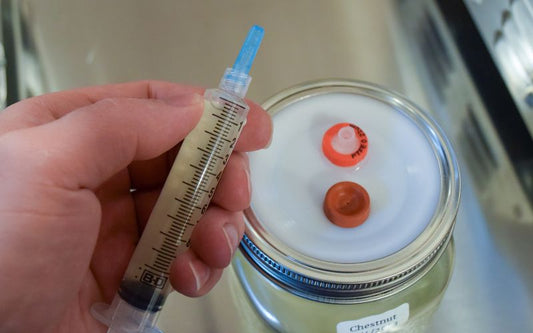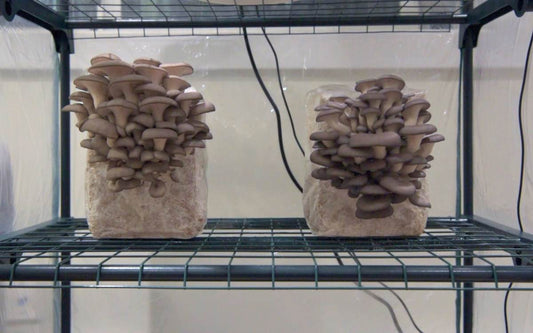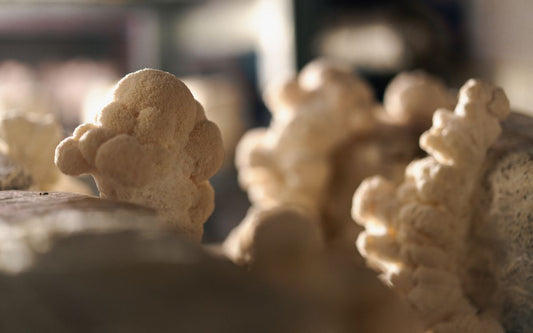Growing lion's mane mushrooms is a rewarding experience.
These unique fungi not only offer a range of health benefits, but also boast a versatile flavour profile that lends itself well to a variety of tasty dishes.
In this comprehensive guide, we will explore different methods of cultivating lion's mane mushrooms, ensuring that you have all the information you need to embark this exciting mycological journey.
Short summary
-
Lion's mane mushrooms are a special type of fungus with health benefits.
-
Growing lion's mane mushrooms requires patience, but is rewarding and relatively straightforward.
-
Different methods exist for cultivating lion's mane, each offering different results and levels of difficulty.
What is lion's mane mushroom?
Lion's mane mushrooms (Hericium erinaceus) are a distinctive fungus, characterized by their white icicle-like teeth that dangle from a central stalk, resembling the mane of a lion.

These mushrooms are typically found on dead and decaying hardwood logs in North America, mainly during the fall season.
Along with their unique appearance, lion's mane mushrooms offer various health benefits due to the presence of substances such as beta-glucans, hericenones, and erinacines, which have been linked to managing inflammation, skin aging, dementia, diabetes, and even cancer.
Is lion's mane easy to grow?
While cultivating lion's mane mushrooms isn't too difficult, it does require some experience and patience due to the delicate nature of the mycelium (the root-like structure of mushrooms).
For those new to mushroom cultivation, it is recommended to begin with more beginner-friendly varieties, such as oyster mushrooms, or opt for a pre-made mushroom kit.

However, with time and practice, growing lion's mane mushrooms can be a highly rewarding endeavor.
Choosing your growing method
When it comes to cultivating lion's mane mushrooms, there are three main methods to choose from: grow kits, grain spawn and hardwood pellets, and log cultivation.
Each method has its advantages and challenges, so it's essential to choose the one that best suits your experience level, available resources, and desired outcome.
In the following sections, we will delve deeper into each of these methods, providing you with all the information you need to make an informed decision and begin your lion's mane mushroom-growing journey.
Grow kits
Grow kits are an excellent option for novice growers or those looking for a low-maintenance mushroom-growing solution.
These kits typically include a ready-to-fruit substate, simplifying the cultivation process and minimizing the effort required on your part.

With a lion's mane grow kit, you can expect to harvest two to three flushes of mushrooms.
Keep in mind that while grow kits offer convenience, they may not yield the same level of control and customization as other methods.
Grain spawn and hardwood pellets
Grain spawn and hardwood pellets is another method for cultivating lion's mane mushrooms.
The method involves combining grain spawn (sterilized grain that has been inoculated with mushroom mycelium) with hydrated hardwood fuel pellets.

This method requires a few extra tools and a bit more expertise than grow kits, but gives you complete control over the growing process.
In the following sections, we will provide a step-by-step guide on how to grow lion's mane mushrooms with grain spawn and pellets, covering everything from gathering supplies to harvesting your delicious fungi.
Log cultivation
If you're looking for a more long-term approach to growing lion's mane mushrooms, log cultivation might be the method for you.
This method involves inoculating hardwood logs with lion's mane mushroom spawn and allowing the mycelium to grow and colonize the logs over time.
While log cultivation requires a bit more patience and initial setup compared to other methods, it can provide you with a consistent supply of fresh lion's mane mushrooms for up to six years.
In the following sections, we will guide you through the process of growing lion's mane on logs, with detailed instructions and helpful tips to ensure your success.
How to grow lion's mane with grain spawn and hardwood pellets
Growing lion's mane mushrooms with grain spawn involves creating a suitable substrate, inoculating it with lion's mane grain spawn, incubating the inoculated substrate, and initiating the fruiting process.
In this section, we will walk you through each step of this method, providing detailed instructions and helpful tips to guide you in your mushroom cultivation journey.
Gather supplies
To cultivate lion's mane mushrooms with grain spawn, you will need the following supplies and ingredients:
-
hardwood fuel pellets
-
wheat bran
-
water
You'll also need these pieces of equipment:
-
scale
-
measuring cup
-
plastic bin or bucket
-
pressure cooker
Prepare substrate
To create a suitable substrate for lion's mane mushrooms, you will need to combine hardwood fuel pellets, wheat bran, and water in the appropriate ratios.
Follow the recipe below to create a 5-pound block:
-
5 cups of hardwood pellets
-
1 heaping cup of wheat bran
-
6 cups of water
Mix the pellets and water in a plastic bin or bucket, letting the mixture soak for 30 minutes.
Next, add the wheat bran, mixing it in evenly, then put the substrate into a mushroom grow bag.

Once your bag is ready, it must be sterilized in a pressure cooker for two and a half hours at 15PSI to eliminate any potential contaminants.
If you don't have a pressure cooker but would still like to grow lion's mane mushrooms from scratch, check out our bucket method that requires zero sterilization.
Inoculate substrate
After your substrate has been sterilized and cooled, it's time to inoculate it with lion's mane grain spawn.
To do this, simply introduce the grain spawn to the substrate and mix it evenly.
It is recommended to add the spawn at a rate of 10% (if your substrate bag weighs five pounds, you'll need to add half a pound of spawn, which is 10% of the substrate weight).
Be sure to work in a clean environment and wash your hands thoroughly before handling the substrate to minimize the risk of contamination.
Incubate inoculated substrate
Once your substrate has been inoculated with lion's mane grain spawn, place it in a warm, dark place for two to four weeks.
During this incubation period, the lion's mane mycelium will colonize the substrate, eventually forming a solid block of mycelium-covered substrate that is ready for fruiting.
The ideal temperature for incubation is between 20-25°C (68-77°F).
Be sure to monitor the substrate during this time for any signs of contamination, such as green mold.
Fruiting your lion's mane
To initiate the fruiting process, make a few small slits (2-4 inches) in the grow bag where the mushrooms will emerge.
Within 5-7 days, you should observe small pinheads (primordia) forming on the substrate.
These pinheads will develop into full-sized lion's mane mushrooms, which will be ready for harvest in an additional 5-10 days, depending on the temperature.

During this time, maintain a high humidity level, provide fresh air exchange, and allow a source of indirect sunlight.
To maintain high humidity, spritz the bag multiple times per day with a spray bottle, and consider using a humidity tent, Martha grow tent, or another kind of fruiting chamber.
Harvesting techniques
When your lion's mane mushrooms are ready for harvest, use a sterilized sharp knife to gently cut the "snowball" off close to the bag.
Alternatively, you can gently twist the mushrooms off with clean hands.
The best time to harvest the mushrooms is when the teeth are about 1/4 inch long or start to brown.
Once harvested, your lion's mane mushrooms can be stored and used in various culinary applications, as we will discuss in the following sections.
Growing lion's mane on logs
Growing lion's mane on logs is an inexpensive and dependable method for obtaining a constant supply.
In this section, we will guide you through the process of growing lion's mane on logs, covering everything from gathering the necessary materials and equipment to inoculating the logs with lion's mane mushroom spawn, incubating the logs, and initiating the fruiting process.
Gathering the necessary materials and equipment is the first step in the process.
You will need:
-
logs
-
lion's mane grain spawn
-
a drill
-
wax
The logs should be freshly cut hardwood, such as oak.
Gather supplies
To grow lion's mane mushrooms on logs, you will need foot-long sections of logs, sawdust inoculated with lion's mane mycelium, and hardwood sawdust.
Oak, beech, sycamore, maple, and walnut trees are all suitable log sources for cultivating lion's mane mushrooms.
Ideally, you should cut the logs during autumn or winter, when the trees have the highest sugar content.
Purchase spawn plugs
Spawn plugs are small pieces of hardwood that have been inoculated with lion's mane mushroom mycelium and are used for inoculating hardwood logs to facilitate outdoor mushroom log growth.
You can purchase spawn plugs from online retailers.
Typically, you will need between 30 and 50 plugs to inoculate a four-foot log.
Inoculate your logs
To inoculate your logs, you will need a drill, hammer, and a small brush or sponge.
Using an 85-millimeter drill bit, drill holes into the hardwood log in a diamond pattern.
Space the holes about 2 inches apart.
Hammer the spawn plugs into each hole, and then cover the holes with wax or a wax-based lip balm to protect the spawn plugs from drying out or being invaded by competing fungi.
Incubate your logs
Once the logs have been inoculated with lion's mane mushroom spawn, they need to be incubated for a minimum of six months before the fruiting process can begin.
During this incubation period, the logs should be stacked in a cool, shady area and watered once or twice per week for 10 minutes to maintain optimal moisture levels.
It is important to avoid placing the logs in direct sunlight, as this can dry out the logs and inhibit the growth of the mycelium.
Initiate fruiting
To initiate fruiting, soak the logs in cold water for a period of 24 hours.
This process, known as "shocking," triggers the mycelium to begin producing fruiting bodies.

After soaking the logs, place them on a raised surface, such as a pallet, to allow for proper air circulation and to prevent contact with the ground, which can introduce competing fungi and pests.
Maintain a high humidity level and provide regular fresh air exchange to ensure optimal growth.
Harvesting techniques
When it's time to harvest your lion's mane mushrooms, use a sterilized sharp knife to gently cut the "snowball" off close to the log.
The mushrooms are ready to harvest when the teeth are about 1/4 inch long or start to brown.
After harvesting, store your lion's mane mushrooms in a cool, dry place, and use them in various culinary applications, as we will discuss in the following sections.
Storing and cooking lion's mane mushrooms
Now that you have successfully cultivated your lion's mane mushrooms, it's time to store and eat them.
In this section, we will discuss the proper storage methods for lion's mane mushrooms, provide some recipe suggestions, and explore the unique features and culinary applications of these versatile fungi.
Storage methods
To ensure the freshness and quality of your harvested lion's mane mushrooms, store them in a ventilated container in the refrigerator for up to a week.

If you have harvested more lion's mane mushrooms than you can consume within a week, dry the excess mushrooms in a food dehydrator or oven, and store them in an airtight container for up to a year.
Recipe ideas
Lion's mane mushrooms are highly versatile and can be used as a seafood substitute in a variety of recipes due to their mild, sweet flavour and spongy texture.
They can be sautéed, grilled, or baked for a delicious meal, and their spongy texture makes them ideal for incorporating into soups and sauces.

There are numerous delicious recipes that can be prepared using lion's mane mushrooms.
Some popular options include lion's mane mushroom crab cakes, vegan BBQ pulled lion's mane mushroom tacos, and lion's mane mushroom pasta.
Health benefits of lion's mane mushrooms
In addition to their culinary versatility, lion's mane mushrooms offer a range of health benefits.
Studies have shown that these fungi can enhance cognitive abilities, including memory, focus, and concentration, due to the presence of compounds such as hericenones and erinacines.

Furthermore, lion's mane mushrooms have been linked to regulating blood sugar, reducing high blood pressure, and supporting digestive health.
Incorporating lion's mane mushrooms into your diet can provide not only a delicious culinary experience but also a boost to your overall health and well-being.
Final thoughts
We hope this comprehensive guide has provided you with all the information and inspiration you need to embark on your lion's mane mushroom cultivation journey.
Whether you choose to start with a grow kit, grain spawn and pellets, or log cultivation, growing these unique fungi can be a rewarding and enriching experience.
Remember that patience, knowledge, and perseverance are key to successful mushroom cultivation, and soon enough, you'll be enjoying the fruits of your labour in delicious and healthful culinary creations.
Frequently asked questions
How long does it take to grow lion's mane mushrooms?
The time it takes to grow lion's mane depends on the method.
Growing lion's mane with grain spawn and wood pellets takes about 3 to 4 weeks.
Growing lion's mane on logs generally takes one to two years to see the first harvest of mushrooms, but with proper care they can continue producing for up to six years.
What are the best growing conditions for lion's mane?
Lion's mane mushrooms grow best in a controlled environment where the temperature is between 60-70°F, humidity is kept at least 70%, there is indirect sunlight or supplemental lighting for at least 8-12 hours each day, and fresh air is exchanged regularly.
With the right conditions, you can be sure of a successful crop.
Where does lion's mane grow in Canada?
Lion's mane grows on hardwood trees in Canadian forests. It can be found in both eastern and western Canada, particularly in British Columbia, Quebec, and Ontario during late summer and fall.

Spenser Smith
I am passionate about mushrooms. My number one goal: help you grow mushrooms in your home!





2 comments
Hi Len. I hope you enjoy growing lion’s mane and that you find it helpful for some of your health issues.